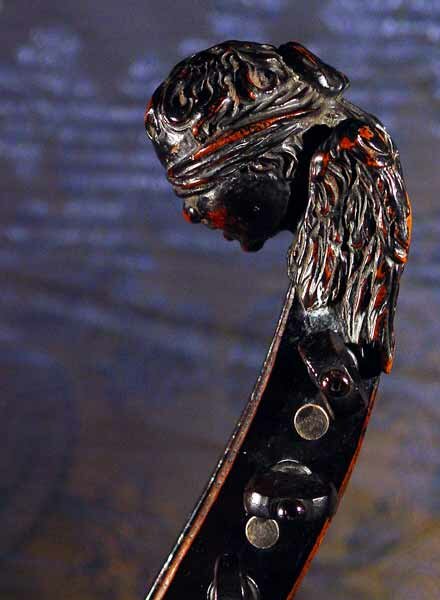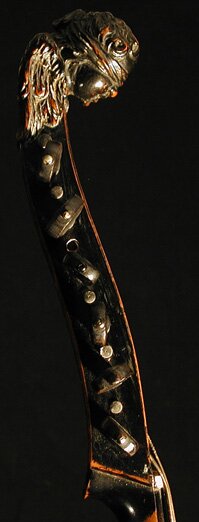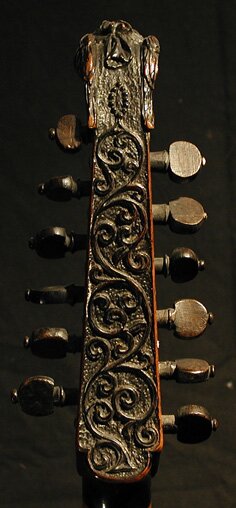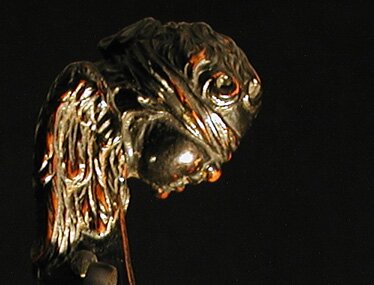Viola d’amore by Johann Schorn Salzburg
Salzburg, ca. 1700
Label: Johann Christoph Leidolff, Wien, 1750
Catalog 52. Viola d’amore – Johann Schorn, Salzburg, um 1700 (signed: Johann Christoph Leidolff – Wien, 1750)
 |
 |
 |
 |
 |
|
 |
|
To judge by the workmanship, the carved head and the overall appearance, this beautiful viola d’amore, although bearing the label of Johann Christoph Leifdolff, was most likely built by Johann Schorn in Salzburg around 1700. The instrument has been preserved in its original condition, including the bridge, all of the tuning pegs, perhaps even the tailpiece. Some of the bass strings appear to be original as well, and will be submitted for examination by string makers.
While still living in Innsbruck, Johann Schorn (1658-1718) received commissions, as had Jakob Stainer somewhat earlier, for instruments from the Archbishop of Salzburg, Max Gandolph von Kuenburg (1668-1687), an enlightened aristocratic clergyman, generous patron of the arts, whose ambitious programmes transformed the city into a center for Baroque art, architecture and music of unparallelled brilliance. It was he who summoned Heinrich Ignaz Franz Biber and Georg Muffat to his service. On the recommendation of the Capellmeister Matthias Biechteler (ca. 1670-1744) Johann Schorn was appointed Court Violin Maker (Hoff Lauten- und Geigenmacher) in 1713, transfering his workshop to Salzburg. The influence of his Innsbrucker colleague, Jakob Stainer is so evident in Schorn’s works, that his violins could easily pass for that maker’s creations. His sons, Johann Paul and Johann Joseph, maintained the very high quality of violin making in Salzburg into the 18th Century.
Working together with the suggestions of Heinrich Biber, Johann Schorn may be rightfully credited with having invented the viola d’amore. Indeed his instruments may be considered the finest of them all. One of his violas d’amore is to be found in our collection. Although bearing the label of Johann Christoph Leidolff, that viola d’amore could hardly be by anyone else but Johann Schorn. The carved head of a blinded Cupid and the decorations on the rear of the peg box are identical to those found in the two violas d’amore known to have been made by Schorn now preserved in the Museum in Salzburg.
This instrument represents the original model for the viola d’amore, with six bowed and six sympathetic strings. Johann Schorn apparently worked closely with the Salzburg Capellmeister Heinrich Ignaz Franz Biber to invent the viola d’amore. Consequently our instrument may well be one of the earliest violas d’amore in history, probably made sometime before 1700! The instrument is in its original state, including the original pegs, fingerboard, tailpiece and even quite probably some of the original strings.
Wolfgang Amadeus Mozart played on a Johann Schorn violin. Ludwig van Beethoven owned a Salzburg violin, at present in the Museum in Bonn, which, although bearing no label, could very well be an instrument of this master or one of his sons.
Johann Schorn (* 1658; † 1718) war Geigenbauer in Salzburg.
Johann Schorn arbeitete zuerst wahrscheinlich von Innsbruck aus als Geigenmacher für Erzbischof Max Gandolph von Kuenburg (1668-1687). 1713 wurde er auf Empfehlung des damaligen Hofkapellmeisters Matthias Biechteler (ca. 1670-1744) als “Hoff Lauten-und Geigenmacher” an den Salzburger Hof verpflichtet. Seine beiden Söhne Johann Paul Schorn und Johann Joseph Schorn arbeiteten mit ihrem Vater in der Werkstatt mit. Ihre auch heute noch qualitätsvollen Instrumente stehen denen der beiden Tiroler Geigenbauer Jakob Stainer und Matthias Alban nahe. Es heißt, dass er zusammen mit dem Salzburger Hofkapellmeister Heinrich Ignaz Franz Biber die Viola d’Amore erfunden habe. (Siehe Wikipedia-Artikel)
| Body length | mm |
|
Upper width
|
mm |
| Middle width | mm |
| Lower width | mm |
| Rib height | mm |
| String length | mm |